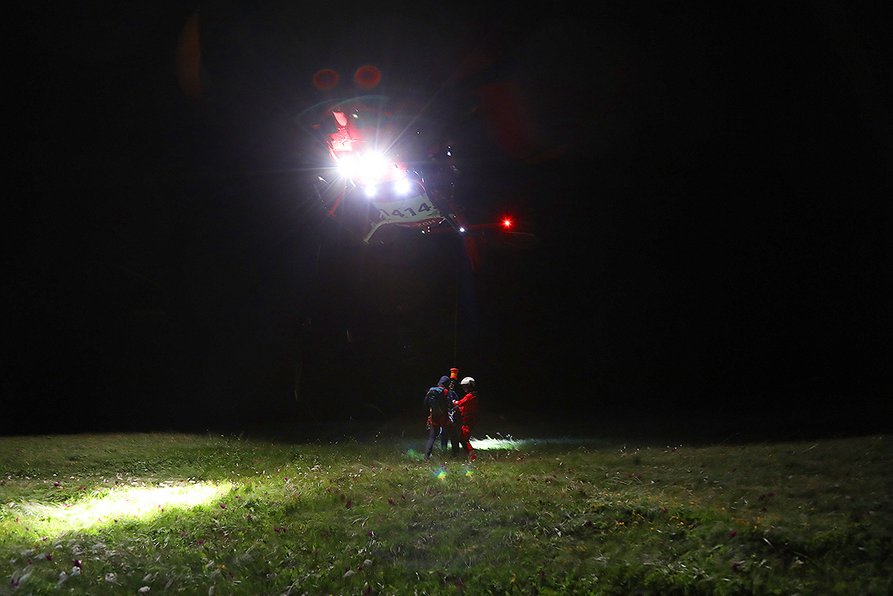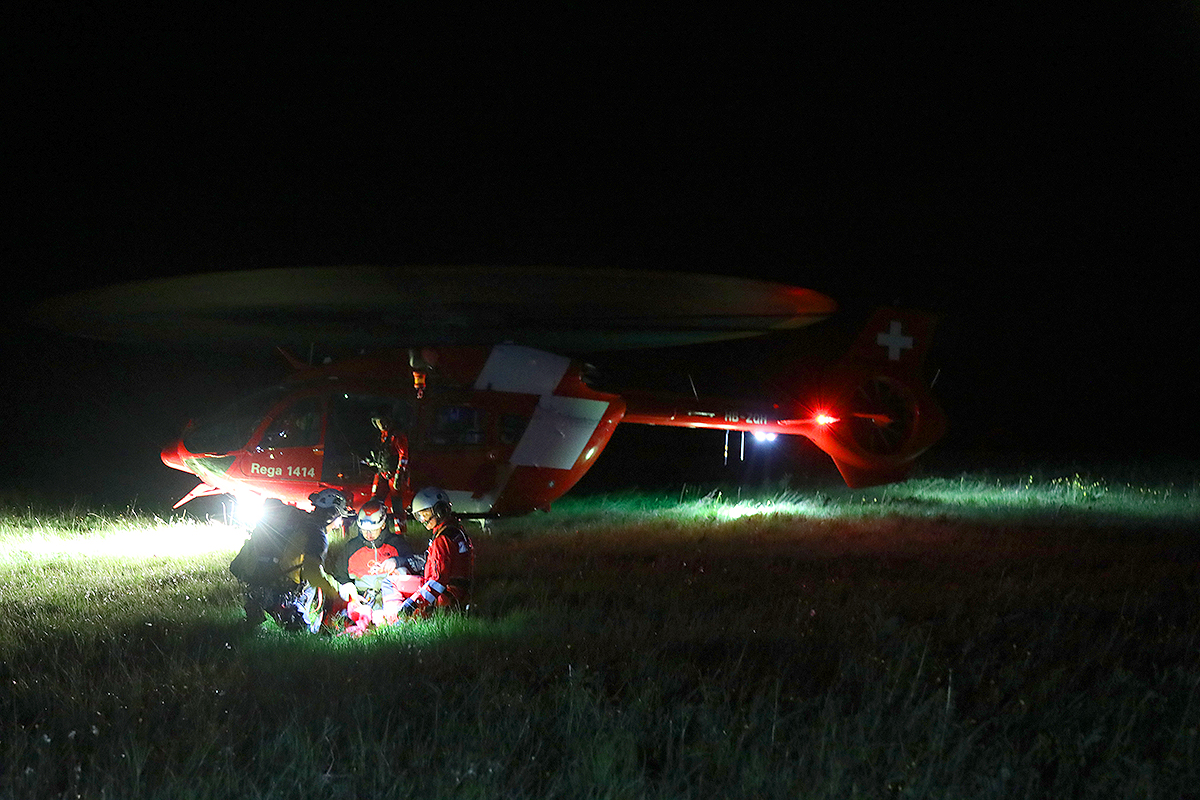It is shortly after 10pm when the crew from the helicopter base in Berne receive the emergency call: five mountain climbers have got stuck in the Aubert-Jumelle region in Canton Vaud and need to be evacuated. The preparations for the mission proceed calmly and even more focused than during the daytime. Emergency flight physician Richard Steffen steps into a climbing harness in readiness for a possible hoist rescue and pulls on a headlamp in addition to the lamp on his helmet. Pilot Simon Luginbühl is already busy preparing the helicopter for take-off. Paramedic Michael Siegenthaler puts on the safety vest that is necessary when operating the rescue hoist and then checks that the so-called "lip light" – a small light attached to the microphone on his helmet, which he can switch on and off by moving his lips – is functioning properly. "Human performance is not as high at night as during the daytime. It’s therefore all the more important to follow procedures precisely and to prepare for a mission with even more concentration than during the day," Michael Siegenthaler explains.
Time to prepare the mission
For this mission in high Alpine terrain, the crew can count on the help of a helicopter rescue specialist, who has already been called out by the Rega Operations Centre. Björn Dysli, a high-altitude rescuer from Protection and Rescue Bern, is waiting at the arranged meeting point by the fire station and climbs on board the rescue helicopter. The subsequent flight to the site of the incident takes approximately 20 minutes – time that is used to prepare the mission. As the mountain climbers have raised the alarm via the Rega app, the exact coordinates of their location are known. Emergency physician Richard Steffen studies the map together with the rescue specialist, and the crew find a small parking area next to a large meadow, very close to where the stranded climbers are located – an optimal temporary landing site for the upcoming evacuation. The approach to the landing site is performed with the utmost of care; the display in the cockpit indicates several cables running across the valley. "Even during the day, cables are often barely visible and are extremely dangerous for helicopters," says Luginbühl. Moreover, the official aeronautical obstacle maps only include cables that are required to be reported and are located at a height of over 25 metres. In 2016, Rega started to record lower-lying obstacles – such as cableways for transporting goods up to the alp – independently in its own database, so that cables and aviation obstacles located under the prescribed altitude are also displayed on a digital map in the cockpit. Rega also makes this data available to other airspace users. "However, in spite of this extensive database, it’s always necessary to exercise particular caution – especially at night, when the cables are virtually invisible," says Luginbühl.
Seeing thanks to night vision goggles
In order to see better at night, Rega’s cockpit crews use night vision goggles, or NVGs, which amplify the residual light and increase visibility. However, Rega’s H145 helicopter has another ace up its sleeve to help pilots get their bearings in the dark: mounted on the helicopter are two extremely powerful, movable spotlights, which Luginbühl can control from the cockpit. "The NVGs and the spotlights are used independently of each other, depending on the situation. If I can get a better visual reference with the bright light from the spotlights, I don’t use the NVGs. But there are many cases where this is not possible and then the NVGs are indispensable," the Rega pilot explains.
Paramedic operates the rescue hoist
With the night vision goggles in front of his eyes, Luginbühl lands his H145 rescue helicopter safely on the Alpine meadow next to the small parking area and allows the emergency flight physician, Richard Steffen, to alight. Steffen outlines the procedure: "We need to fly around several times to evacuate all five climbers, who are in two different places on the rock face. I’ll then meet them on the ground and detach them from the rescue hoist hook." Meanwhile, the helicopter flies off into the dark night to set down Björn Dysli next to the first group of climbers. Now, once again, precision work is called for. With brief commands, paramedic Michael Siegenthaler directs the pilot exactly over the place where the climbers are located. Around 75 metres above the group, Luginbühl holds the helicopter in position and as steady as possible, while Siegenthaler lowers the rescue specialist, suspended on the end of the hoist, to the climbers. Missions with the rescue hoist at night are particularly challenging for all the crew members. While during the day, the paramedic can clearly see the terrain below him, it is much more difficult in the dark: distances are harder to judge and the hoist hook becomes invisible as soon as it disappears below the cone of light from the spotlights. On this particular day, the situation is made even more difficult by the foehn wind, which is blowing strongly. Experience, precision and unreserved trust in the abilities of the other crew members are the key to a successful night rescue with the hoist.


